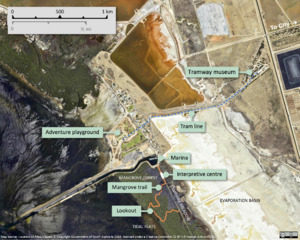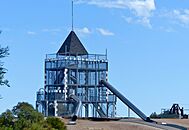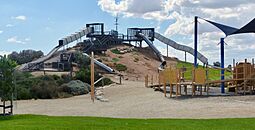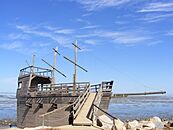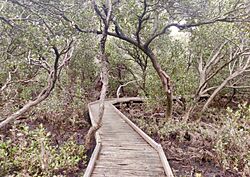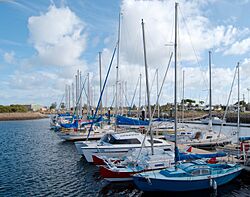St Kilda, South Australia facts for kids
Quick facts for kids St KildaAdelaide, South Australia |
|||||||||||||||
|---|---|---|---|---|---|---|---|---|---|---|---|---|---|---|---|
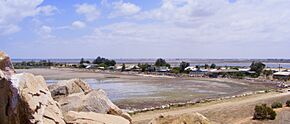
Northern part of St Kilda township
|
|||||||||||||||
| Established | 1893 | ||||||||||||||
| Postcode(s) | 5110 | ||||||||||||||
| Location | 22 km (14 mi) from Adelaide city centre | ||||||||||||||
| LGA(s) | City of Salisbury | ||||||||||||||
| State electorate(s) | Port Adelaide | ||||||||||||||
| Federal Division(s) | Spence | ||||||||||||||
|
|||||||||||||||
|
|||||||||||||||
| Footnotes | Climate Adjoining suburbs |
||||||||||||||
St Kilda is a small coastal town, now known as a suburb. It is about 21 kilometers (13 miles) north-north-west of Adelaide, the capital city of South Australia. Not many people live here, and only one road connects it to the main highway. This means its natural beauty and buildings have stayed mostly untouched.
The area by the sea has many mangrove trees. It faces the Barker Inlet, which is part of the Port River area. St Kilda is famous around the world for bird-watching. More than 100 types of birds come to feed in the mudflats, salt lagoons, mangroves, and seagrass beds.
The part of St Kilda where people live is quite small. The rest of the land used to have many salt evaporation ponds, but now there are fewer. Some ponds from the Bolivar Waste Water Treatment Plant are at the southern end of the suburb. St Kilda is surrounded by Buckland Park to the north and Bolivar to the south.
This suburb has fun places to visit. These include a huge adventure playground, a tram museum, a walk through a mangrove forest, and lots of amazing birds.
A Look Back in Time
Before European Settlers Arrived
Before 1836, when the British came to South Australia, the Kaurna people lived here. Their land stretched from Cape Jervis in the south to Crystal Brook in the north. They called the Port River area Yerta Bulti, meaning "land of sleep or death".
The Kaurna people used the river area a lot for finding food and materials. They would catch fish, lobsters, and birds. They also gathered bird's eggs, mussels, and crabs. They used reeds and rushes to weave baskets and nets. These nets helped them catch fish and animals like kangaroos and emus.
After European Settlers Arrived
The town of St Kilda was officially marked out in 1873. By 1865, fishermen had already built small huts on three low islands. These islands were covered in shells and saltbush, surrounded by mangroves and samphire swamps. By 1873, there were 13 huts and a boathouse.
In the 1890s, people from Adelaide started visiting. They liked the mangrove mud, which they thought could heal them. They also enjoyed swimming and fishing for crabs. An early settler, John Harvey, named the area. It reminded him of the isolated St Kilda archipelago in Scotland.
In 1886, the District Council of Munno Para West looked after St Kilda. The town was officially declared on July 31, 1893. The first land sales happened on the same day.
The St Kilda Hotel opened in 1898. It was built from limestone found 15 kilometers (9 miles) to the east. It is still the only hotel in the town. A school opened in 1902 where the tram museum is now. It closed for good in 1949.
After big floods in 1948 and 1957, the three islands were changed a lot. The local council started building up the area. They made seawalls bigger and added more land using earth.
Large salt ponds were built starting in 1935. About 600 workers dug them by hand. After World War II, machines helped expand these ponds.
St Kilda has always been a small place. In 2021, there were only 88 people living in 57 homes. Many of these homes are not very big or strong.
Fun Things to Do
The Awesome Adventure Playground
| A castle at the playground (and zipwire on right) | Tunnels and slides at the playground "volcano" | A children's "pirate ship" on the waterfront |
The St Kilda adventure playground is huge, covering 4 hectares (10 acres) by the sea. Kids have voted it the best adventure park in South Australia! It has:
- a "pirate" shipwreck
- a three-story castle
- tunnelled slides on a hill
- flying foxes
- a "bouncy boomerang"
- many other fun play things
Younger children can enjoy shaded equipment and a small maze. There are also barbecue areas, basketball courts, and a dog-friendly exercise space.
The playground opened in 1982 and was updated in 2016. It was started by the Lions Club of Salisbury. Funding came from club events, the City of Salisbury council, and government programs.
The Tramway Museum

Adelaide's tram museum is in St Kilda. It is on the site of the old primary school. The museum has 24 electric trams, 2 horse trams, and 5 trolleybuses. These were all used or built in Adelaide. Most of them are fixed up and can still run.
The museum is open on Sundays and most public holidays from noon to 5 pm. It is one of the few museums in the world that has at least one example of every main tram type used in a city. Your entrance fee lets you have unlimited free rides on an electric tram. The tram travels 1.6 kilometers (1 mile) between the museum and the adventure playground.
Mangrove Trail and Learning Centre
St Kilda is built on a mangrove forest. This forest is next to Barker Inlet, which is part of the biggest tidal river mouth in Gulf St Vincent. There is a special learning centre that teaches you about the plants, animals, and processes in the mangrove forest.
From the centre, a 1.7 kilometer (1.1 mile) trail goes through a flooded mangrove forest. Most of this trail is on a raised boardwalk. The trail winds through tidal samphire saltmarsh flats, mangroves, and seagrass channels. It leads to a lookout point with great views over the Barker Inlet.
Boating and Fishing Fun
There is a marina with floating spots for about 75 boats. Some boats are more than 10 meters (33 feet) long. There are also two boat ramps. A long, calm channel connects the marina to the Barker Inlet.
The St Kilda Boat Club is located here. It offers safe parking, places to repair boats, and a special lift to help people get onto boats. The breakwater is a popular spot for recreational fishing. People often catch salmon trout, whiting, and bream here.
Nature and Environment
St Kilda is a flat, low-lying area, mostly less than 2 meters (7 feet) above sea level. It used to have many large salt crystallisation lagoons. Now, many of these salt fields are closed. The land and water are being restored. Large treatment ponds from SA Water's Bolivar waste water treatment plant are to the south.
Salt Fields
The coast near the mangroves has large salt evaporation ponds. These are rented for industrial use by the South Australian Government. Today, most of these salt fields are not used anymore. The government makes sure these areas are protected and restored.
A company called ICI Australia Ltd started making salt at Dry Creek in 1940. They also had a soda ash plant nearby. This company sold its operations in 1989. In 2006, when more salt fields were working, they covered about 4,000 hectares (9,900 acres). Salt water was pumped from the sea. The salt was then dissolved again and pumped to the plant to make soda ash.
In 2020, a government check found that many mangrove trees had died. They also saw that salty water had been pumped into the salt fields. The reason for the mangrove die-off was still being investigated.
Plants of St Kilda
The mangroves along the St Kilda coastline are all one type, called Avicennia marina. Closer to land, the mangroves become smaller. They then change to different types of samphire plants. These include beaded glasswort and blackseed glasswort. Nitre bush grows on the highest parts of the seawall. Its summer fruits provide food for birds.
Animals of St Kilda
St Kilda is a very important place for young fish and crustaceans. Many commercially important fish, like King George whiting, western king prawns, and blue swimmer crabs, grow up here. You might also see brown snakes and skinks in the thick bushes.
Every late summer, thousands of black swans and ducks come to the area. This happens when their inland homes dry up. Waterbirds like pelicans, cormorants, oyster catchers, and terns are common all year. Egrets, ibis, herons, and spoonbills feed on the seagrass. Small birds like fairy wrens, chats, fantails, and thornbills eat insects and plants among the samphire.
Every September, stints and sandpipers arrive from the Northern Hemisphere. This is a spectacular sight! All these birds attract birds of prey. You can see swamp harriers, collared sparrowhawks, black-shouldered kites, kestrels, and little falcons flying over St Kilda.
The salt lagoons, mangroves, and samphire wetlands are very important for migratory birds. They are protected by agreements like the China-Australia and Japan-Australia migratory bird agreements.
Protected Areas
St Kilda and its surrounding waters and land are very special. Because of this, they are part of several protected areas:
- Adelaide Dolphin Sanctuary
- Barker Inlet – St Kilda Aquatic Reserve
- Gulf St Vincent Important Bird Area
- St Kilda – Chapman Creek Aquatic Reserve
- The planned Adelaide International Bird Sanctuary National Park.
Getting Around and Weather
Transport
It's a bit tricky to get to St Kilda using public transport. The closest bus stop is 4.6 kilometers (2.9 miles) from the tramway museum. It's even further, 6.3 kilometers (3.9 miles), from the adventure playground.
Weather in St Kilda
The area has a Mediterranean climate. This means it has hot, dry summers and mild, wet winters. St Kilda is usually a bit hotter and drier than the average climate of Adelaide. In summer, daytime temperatures might go over 40°C (104°F) about four days a year. In winter, nighttime temperatures might drop below 0°C (32°F) about one day a year. Generally, winters are mild with some rain.
The graphs below show climate data for RAAF Base Edinburgh. This base is 10 kilometers (6 miles) inland from St Kilda.
| Weather chart for RAAF Base Edinburgh | |||||||||||||||||||||||||||||||||||||||||||||||
|---|---|---|---|---|---|---|---|---|---|---|---|---|---|---|---|---|---|---|---|---|---|---|---|---|---|---|---|---|---|---|---|---|---|---|---|---|---|---|---|---|---|---|---|---|---|---|---|
| J | F | M | A | M | J | J | A | S | O | N | D | ||||||||||||||||||||||||||||||||||||
|
21
30
17
|
17
30
17
|
23
27
15
|
31
23
12
|
47
19
9
|
53
16
7
|
52
15
6
|
50
17
7
|
47
19
8
|
37
22
10
|
26
26
13
|
25
28
15
|
||||||||||||||||||||||||||||||||||||
| temperatures in °C precipitation totals in mm source: Bureau of Meteorology |
|||||||||||||||||||||||||||||||||||||||||||||||
|
Imperial conversion
|
|||||||||||||||||||||||||||||||||||||||||||||||



